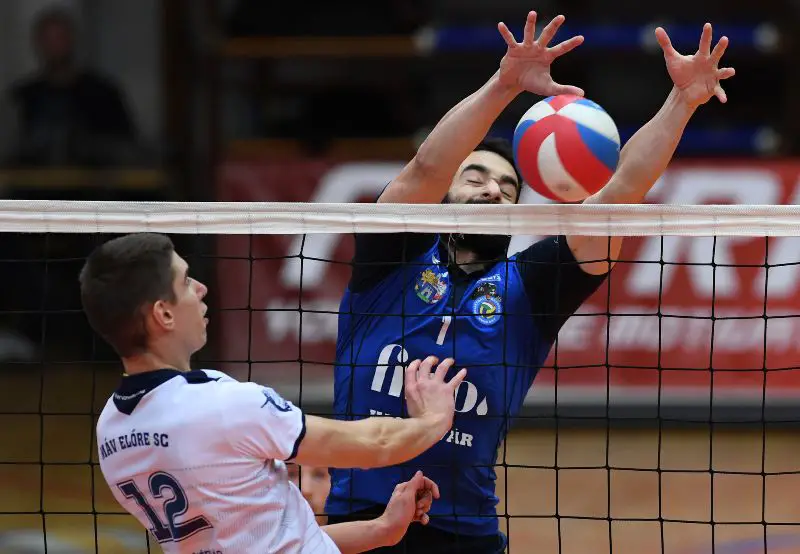
Being short could be frustrating for some volleyball players who are in a position where they have to block an upcoming ball from the opposite team. However, with the necessary adjustments you can overcome this lack of height and do a good job …
In this article, I breakdown some simple yet effective tips to block properly in volleyball even if you are not tall enough.
Hope this will help.
4 Tips to Block in Volleyball if you are short …
Tip 1: Improve your Vertical leap
Practicing the vertical leap will help you in increasing your overall effectiveness in volleyball because most moves are based on it. This requires a lot of practice but it can have an enormous impact on your skills on the court.
There are many different practices that can help you with your vertical leap. One of them is the wall jump.
The wall jump is a simple, but effective practice. Take a sticker, stand in front of a wall and jump as high as you can (performing a blocking move), sticking the sticker to the wall.
The sticker serves as an indicator of your jump. Whenever you want to practice your vertical jump try using this method, since it can show you clearly how your jumping is progressing.
Helpful Tip: One way to increase a little bit your vertical reach when jumping is by using volleyball shoes with pretty high soles. For example these quality volley shoes will help leverage your jumps in case you are shorter than average.
You can learn more about improving your vertical jump for volleyball!
Tip 2: Swing back
Swing back is a common blocking technique and is purely the opposite of a regular block, where you stand in place and jump vertically. That does not mean you do not have to work on your vertical leap.
The Swing back is basically a block that requires momentum. For an example, you as the blocker will attempt to block the opposite teams outside hitter. This means that you will have to move from left to right.
To begin with you will need to be in your base position. This is necessary because you will have to do a three step jump before blocking. The size of the steps does not matter, what matters the most is the jump and the momentum you build.
Secondly, you need to make two steps, first with your right, then with your left. It is important that these two steps are „large“ because the third step (right footed) will be mainly there to propel you into the air. Those first two steps are there for you to build your momentum.
When you position your right foot after the first two steps, align your hips with the net, and swing your arms up, in the direction of the block, that is the opposite teams hitter.
Your arms, besides being there for the block, help you with building up additional momentum. Then, you should be able to propel yourself high enough to make a solid block.
Tip 3: Soft block
A soft block is in reality not a block, but it is rather a tactical move, helping your team and disrupting the opposite team spike by getting your hands in the way of the ball.
The goal here is to reach as high as you can with your hands. If the ball is going on a downwards spiral, you should be able to intercept it.
Do the usual when you perform a block, but do not go with your hands over the net, instead just keep them in the air, and disrupt the ball so your defense can do their part.
Tip 4: Over the net practice
Over the net practice is a monotonous practice that can help you jump over the height of the net. As the vertical leap, it can help you with the height of your jump, but it can be monotonous sometimes, since it is basically jumping up and down.
It would be nice if you combine both practices, that is the vertical leap and over the net in order to get faster and better results.
Lastly … highly invite you to check those other volleyball skills!
How tall do you need to be to block in volleyball?
Generally, a blocker needs to be tall enough to reach over the net …
The height of the net for men’s volleyball is 2.43m and for women’s volleyball is 2.24m. We can see that there is a difference of 19 centimeters.
Now, for men’s volleyball a player needs to be able to jump at least 20-25 centimeters above the net. It seems high, but it is not, considering that an average hitter/blocker has the height of the average blocker which is around 180 centimeters. This means that if he puts his hands up, he will easily reach the height of the net, or maybe even go over it.
We can see that the minimum of 20-25 centimeters over the net is basically a norm. When it comes to women’s volleyball, things are basically the same, but on a smaller scale.
The net in women’s volleyball has a height of 2.24m. That is because women tend to be shorter than men in volleyball. The minimum jump over the net of 20-25 centimeters is also achievable.
Male players in volleyball have an average height range of 178cm to 210cm. The taller ones, exceeding 185cm will usually be positioned in the front of the net.
In female volleyball the average height is between 168cm and 195cm, meaning that female players who are above 175cm will be regarded as possible blockers.
How can positioning help short players blocking?
Positioning in volleyball is critical, especially for short players …
Positioning in general can be a decisive thing. If a player is not positioned properly he may not be able to intercept the ball and he may not be able to play effectively and in full swing.
When it comes to short players, positioning can mean everything during a game. I have mentioned the swing back earlier, well that is because the swing back is a good example how positioning can help short players succeed. Swing back is all about positioning and it is a good example.
If you are a short volleyball player, it is best for you to position yourself in a way that will enable you to gain momentum while jumping for a block.
The momentum can, and will carry you higher than a regular jump would. The jump should be performed so that it can give you an upper hand against your opponents (meaning that the positioning comes after the jump).
Being able to position and align yourself perfectly with the opponent is not that easy and requires a lot of practice.
Drills to help vertical jump for short players …
The first way of practice is performed with a wall and a few stickers. Mark the wall at 2.43 or 2.24 meters. After that, stand in front of the wall and jump as high so you can, in a block move, and stick the sticker to the wall, marking your height. Practicing this can help you have a clear insight in the height of your jump.
The next drill is a universal one, and is related to hitting and it can actually help your jumping abilities. Short players play the role of hitter as well, so this can help them too.
The drill is called hitter on box. Your coach will stand on a box, or any other object that can provide him with enough height to toss the ball towards you.
You will execute a hitting move, but the goal is to reach above the height of the net.
Your coach will throw the ball at you while your goal is to hit the ball as hard as you can, while simultaneously trying to reach the height of the coach’s throw.
The second exercise may not seem as a blocking exercise, but it really helps with the vertical jump, and it is an interactive way of practicing, contrary to jumping into thin air.
Best Role for short players in volleyball court!
The first position that is best suited for short players is the position of libero. This position is considered by many as the best position for short players because it requires someone with sharp reflexes and speed.
A libero should be able to move quickly, and react as fast as possible. The position of libero is a purely defensive role and he is forbidden from offensive tasks. He can be distinguished from his teammates by the different color of his uniform.
The second position that is best suited for short players is the position of the defensive specialist. The defensive specialist comes into play when the defense needs to be reinforced. The defensive specialist goes in when a less capable player comes into the back row.
The name of the position says it all. The defensive specialist is often short and is, just like the libero, fast and explosive with sharp reflexes. When the defensive specialist comes into the first row, he exits the game, since he is no longer required.
Final Thoughts …
If you are short and love volleyball, seriously don’t get discouraged! I’ve seen many players who were not that tall and still managed to do just fine …
Blocking, hitting and even diving are all moves that shorter players are supposed to struggle with. Yet with proprietary practice you will overcome that.
Finally, if you don’t have access to a court, then I highly invite you to check those blocking drills you can practice at home!
